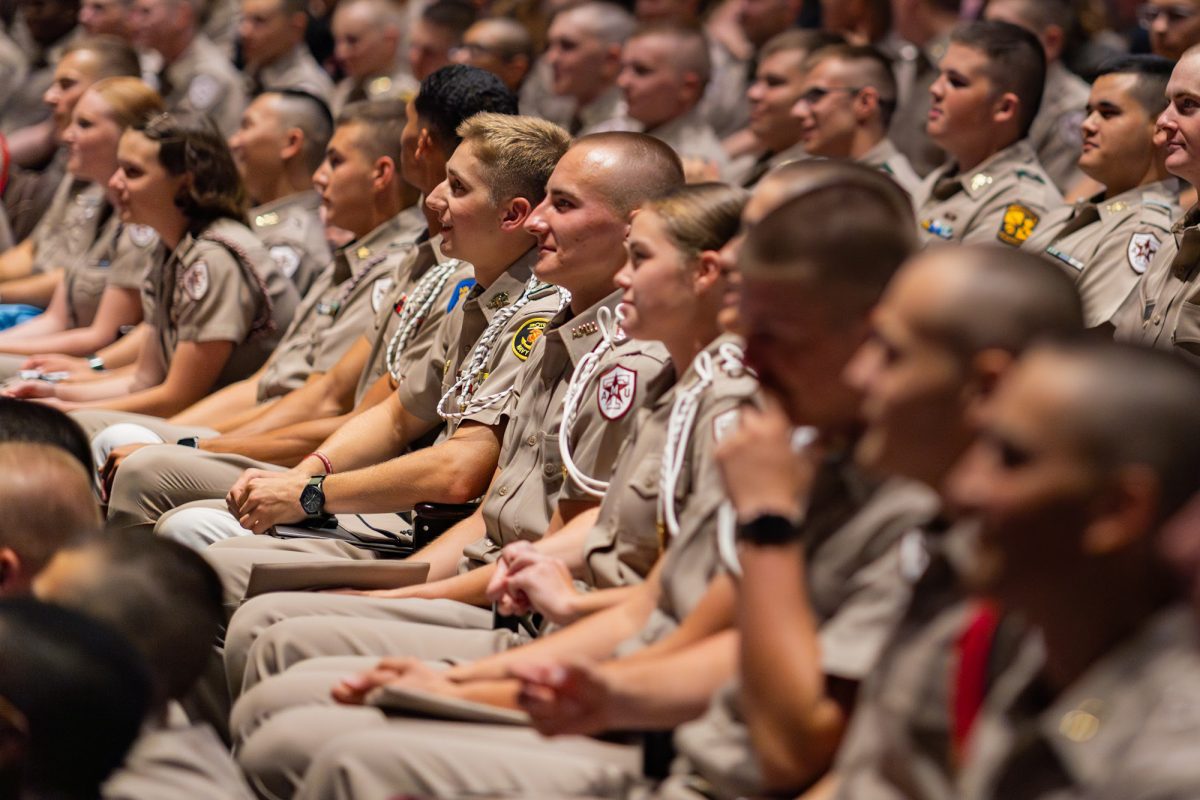It is a quiet Friday morning on campus and senior Wildlife and Fisheries major Ryan Walser unfolds a tree-like radio antenna. He’s going squirrel-hunting. Walser dials in the frequency of a nearby squirrel, and a soft beeping sound emanates from the radio receiver slung over his shoulder. He walks a few steps and the beeping grows louder. He scans the trees for the target. Then, in a sudden blur of motion, a collared squirrel zips across the pathway and disappears into a parking lot. Like an eager paparazzi, he pursues the squirrel between the parked cars, camera ready, but this nervous specimen will not appear for a photo op. He briefly sees it peering out from the wheel well of a parked car. Then it disappears, scampering past and hiding in a row of oak trees near the Psychology Building.
The elusive squirrel is one of 23 eastern fox squirrels sporting a black radio collar on the Texas A&M campus as part of the Aggie Squirrel Project. Besides drawing curious and adoring looks from passersby, the collared squirrels are helping students and scientists learn more about how squirrels live with people. Wildlife and Fisheries Professor Roel Lopez began the project two years ago.
“The idea was twofold – to basically come up with a way of offering undergraduates hands-on experience and to gain an understanding of urban squirrel dynamics,” he said. The study is the first of its kind, Lopez said, and it will attempt to fill a gap in the understanding of how wild squirrels adapt to urban environments. Squirrels are often perceived as cute and harmless, but they can become a nuisance in urban settings when they chew on buildings and wires, Lopez said.
Graduate student Bob McCleery, who manages the project as part of his dissertation research, agrees that there is a dearth of knowledge about how squirrels adapt to the presence of thousands of humans. He cites the begging behavior of squirrels as one example of adaptation – the squirrels have learned that “people are a wonderful source of food.”
City life offers perks other than free handouts from humans. Common squirrel predators such as bobcats rarely hunt near populated areas, so urban squirrels enjoy a greater sense of security. In one exception, McCleery recently observed a hawk snacking on a squirrel outside the architecture building. Still, the combination of fewer predators and more people should alter the way squirrels behave, McCleery said.
Each of the 20 to 30 tagged squirrels is monitored at least three times a week by the project’s student interns. The project aims to track at least 10 male and 10 female squirrels throughout the year. Using radio telemetry, the students home in on a squirrel’s radio frequency.
After sighting the squirrel, they note whether the squirrel is on grass or pavement, in a tree or on a building. Walser says the squirrels typically occupy a limited home range on campus. For example, a squirrel found one day in the vicinity of the Academic Building is likely to be found in that same area later in the week.
There are rare occasions when the squirrel searchers must cast a wider net. Squirrels have been known to disappear, taking their battery-powered radio collars beyond the range of the homing antenna. Relocating their signals can require extensive legwork.
“If you’re not getting (the signal) you may have to drive around,” McCleery said.
McCleery said he believes some of the squirrel movement can be attributed to territorial disputes. Although squirrels forage together and occupy overlapping ranges, they also appear to observe a social hierarchy in which the bigger squirrel is allocated more territory. McCleery said many of the squirrels that bolt for new territory across George Bush Drive or Wellborn Road appear to be “young, male squirrels that have been pushed along.”
Crossing the busy streets in and around campus is a risky proposition for the squirrels. McCleery said the major source of mortality among the project squirrels is running out into traffic. Last semester, students tracked down four or five squirrels that had been run over by automobiles, Walser said. A few others drowned in sewage pipes. The squirrels’ radio collars are fitted with motion sensors. If the collar doesn’t move in eight hours, the beacon switches into a different mode, producing a fast series of beeps. The researchers can then retrieve the collar and refit it for use on another squirrel.
When squirrels leave campus or die, they are removed from the study, and McCleery and his team of students must collar new squirrels. First, they place cages on the branches of trees where squirrels typically roam and lure the squirrels inside with a mixture of sunflower seeds, pecans and peanut butter. McCleery said they’ve chosen not to use chemicals to sedate the squirrels, partly because handling an active squirrel and fastening a radio collar around its neck is a challenge, but it is an invaluable learning experience for the students. A captured squirrel is a “squirmy little thing that isn’t happy you’re holding on to it,” McCleery said. “It’s an important teaching tool.”
The students also apply different survey methods to estimate the total campus squirrel population. They are especially interested in the number of new offspring and the survival rate of offspring during the spring and fall breeding seasons; this information will help to show whether the population is expanding or dwindling. To count the number of newborn squirrels during breeding seasons, the students use cameras on long poles to spy inside ready-made squirrel boxes posted high in the trees around campus. In rural settings, squirrels dwell in the hollows of dead trees, but dead trees are not readily available on a carefully manicured college campus. As it turns out, the squirrel boxes are a convenience for both squirrels and scientists. The female squirrels have safe places to nest, and the scientists know where to find them. Occasionally, Walser said, an owl or a swarm of bees will commandeer a squirrel habitat.
“You want to stay away from the ones with bees,” he said.
As the Squirrel Project enters its third year of data collection, Lopez said he sees no end in sight. The research is relatively inexpensive, he said, and it’s a great way to teach students about wildlife management techniques. McCleery notes that students would otherwise have to travel for three-month periods to faraway research sites to fulfill their internship requirements for a degree in Wildlife and Fisheries.
Planning is underway for a companion study of a rural squirrel population near College Station to begin in the coming months. The study will provide a control group of wild squirrels, which the urban squirrels will be compared to. McCleery also plans to focus the lens of research on his own species by surveying the attitudes of Aggies toward their furry neighbors.
For further information about the Aggie Squirrel Project, visithttp://apc.tamu.edu/squirrel/
Researchers continue monitoring campus squirrels
January 27, 2004

0
Donate to The Battalion
Your donation will support the student journalists of Texas A&M University - College Station. Your contribution will allow us to purchase equipment and cover our annual website hosting costs.
More to Discover








